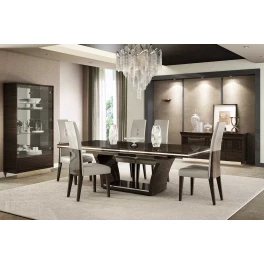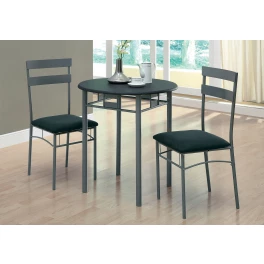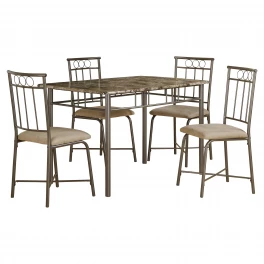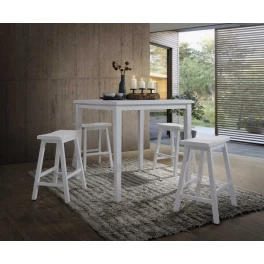From the 1930s through the early 1970s, mid-century modern interior design, decor, and architecture was all the rage, and for good reason!
Characterized by crisp and clean lines combined with subtle curves, natural materials mixed with metallic accents, and overall timeless quality; mid-century modern set the standard for the enduring designs that we still see today.
If anything, the popularity of mid-century modern designs has only increased in recent years.
Check out a friend’s living room, tour a home design studio, or go shopping at any major home goods retailer, and you’re bound to see an abundance of mid-century modern-inspired motifs.
Because this style effectively combines essential functions with classic form, it is particularly common in areas of the home where people gather, such as kitchens. Whether you are working with a small kitchen, a more open kitchen, or a galley kitchen; mid-century style can be incorporated wonderfully.
Are you in the process of revamping your kitchen's layout or currently seeking out some kitchen ideas? If so, consider these mid-century modern kitchen design ideas.

Photo by Nikola Balic on Unsplash
Mid-Century Modern In a Nutshell
Born from post-war Germany, mid-century modern design came about in a time of suburban boom when the number of homeowners steadily increased, and the need for furniture and home decor quickly followed suit.
During this time, there were also innovations and advancements in common household materials, particularly plastics, plywood, and acrylics. The use of these seemingly cutting-edge materials combined with traditional materials like wood and glass ensured furniture and home decor manufacturers could make enough product for their consumers.
Thus, mid-century modern met the needs of a new, eager base of homeowners.
Naturally, this design has evolved since the 1930s. However, the main mid-century modern principles remain the same through today. These include:
- A focus on function with few, if any, accents
- Organic forms combining clean lines with natural curvatures
- Mixed materials
- An overall simple, uncluttered aesthetic
Why Choose a Mid-Century Modern Kitchen Layout?
Because of its classic appearance and relative omnipresence in today’s retail landscape, mid-century modern kitchen layouts are a smart choice for most homeowners.
Here are a few reasons why you won’t regret choosing mid-century modern inspiration for your gallery.
1. It’s Everywhere: Although it has evolved over the past half a century, mid-century modern style is still going strong. In fact, there’s an entire spectrum of designs that fit into this stylistic category, from the conventional 1950’s kitchen to the contemporary mid-century modern found throughout Southern California and in Europe. It’s remarkably easy to find mid-century cabinetry, countertops, furniture, and lighting to meet your specific needs.
2. It’s Bound to Stand the Test of Time: Opposed to other aesthetics that come and go (I’m talking about you, 1970’s plaid), mid-century modern has never gone out of style. Not overdone or underwhelming, mid-century kitchen decor transcends time and remains fashionable.
3. You Can Make it Your Own: You don’t have to go “all in” to be a part of the mid-century movement. Even one or two simple touches can give your entire kitchen a mid-century look, while also saving you money and the stress of finding an intact and working avocado-hued refrigerator.
5 Popular Mid-Century Modern Kitchen Layout Ideas

Photo by Wirestock, Inc .on Alamy
1. Wood
Out of all the ways you can potentially incorporate the mid-century modern look into your kitchen, wood is the most obvious choice.
When you use it as part of your mid-century modern kitchen layout, wood doesn’t just become the focal point of your kitchen; it also evokes a sense of natural warmth.
Great places to incorporate wood into your kitchen include:
- Kitchen cabinets
- Storage racks and open shelves
- Wood paneling on walls
- Exposed beams
- Furniture, such as bar stools and kitchen table
Just be careful. You can overdo wood in the kitchen. For example, if you choose to go with natural wood cabinets, skip the floor-to-ceiling wood paneling.

Photo by karthi keyan.M on Shutterstock
2. Simple Cabinetry
Mid-century modern kitchen cabinet doors are known for their simplicity. Flat-faced wood without grooves or bevels is the norm. If you do want to add a touch of pizazz, try adding a funky oval-shaped mid-century modern cabinet pull or a simple round knob.
On the other hand, many mid-century modern cabinets forego the hardware altogether.
Although wood is the natural choice for cabinetry, don’t feel limited to this option. Other possibilities include high-gloss solid surface glass, plastic, and even stainless steel.
3. The Right Seating
If you want to go the mid-century modern-route, but are working with a limited budget, ignore the big-ticket renovations like the cabinets and countertops, and focus instead on the seating.
When it comes to mid-century kitchen furniture, your choices are limitless.
Do you have a central island? Focus on finding the perfect bar stools that combine materials such as walnut legs and a leather seat, brass accents on a plush upholstered seat, or acacia wood with a rattan back.
For the kitchen table, the focus should again be on mixed materials. Don’t be afraid to combine man-made and natural to create the perfect look.

Photo by david yohanes on Pexels
4. Subtle Colors
Although traditional mid-century modern is simple by nature and is usually assumed to resemble a modern white kitchen, contemporary mid-century modern kitchens don’t always abide by this rule.
On the contrary, hints of subtle color can easily transform a basic kitchen into a work of art.
Try incorporating color on your cabinets or via a tiled backsplash. Your small and large kitchen appliances, including stand mixers, ovens, and refrigerators, can also serve as a canvas of color.
5. Natural and Artificial Light
Lighting plays an essential role in the kitchen, particularly those in homes built during the mid-century boom. Wide windows and glass doors are just two of the ways mid-century architects and designers sought to bring light into a kitchen.
Of course, adding natural light to an established kitchen is potentially very difficult and/or expensive. Potentially barring a full kitchen remodel, you'll have to make use of what you have. Limit the use of curtains or blinds and allow natural sunlight to flow through your kitchen.
While natural light may be optimal, an abundance of it may not be possible. In this case, focus on your artificial light sources. If anything, you want as much lighting as possible to ensure that your kitchen is a safe and gather-worthy place. Add pendant and ceiling lights featuring glass globes and fabric shades wherever necessary.
Regardless of whether you go all in on the mid-century modern design aesthetic, or you just add a few choice elements to give your space some oomph, this style definitely adds an alluring simplicity to your kitchen that’s guaranteed to remain popular for decades to come.


























